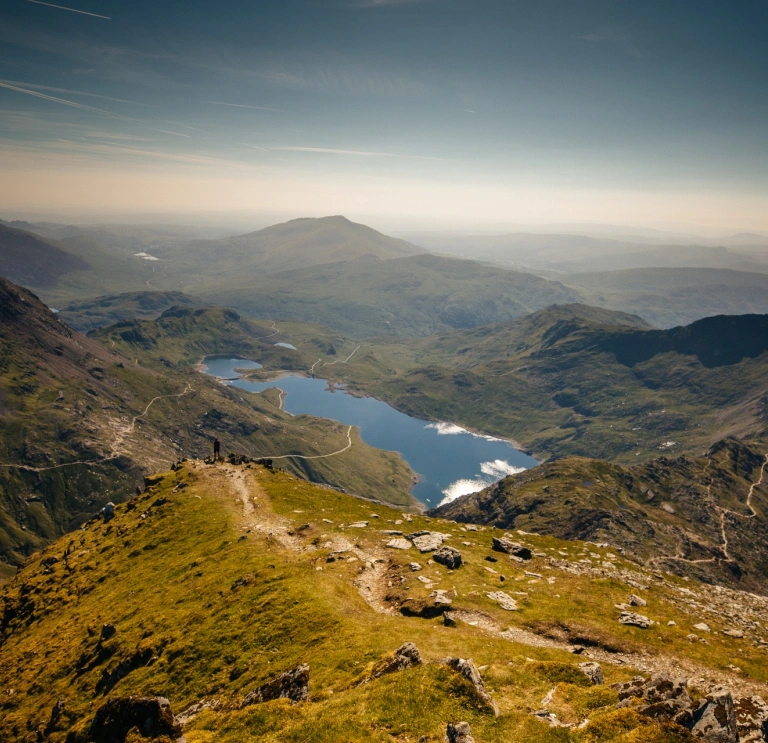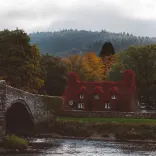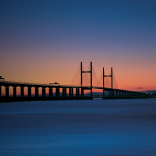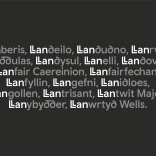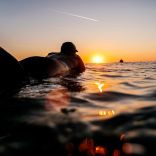Wales (Cymru in Welsh) is the friendly, green, hilly country on the western side of Great Britain. We are about two hours west of London by rail or by road.
Although it’s also a part of Great Britain, Wales is a very different place from our neighbour England. For starters, we have our own language, Welsh (Cymraeg), which has been used in Britain for over 1000 years and is still spoken by more than a quarter of the Welsh population – though we all speak English too.
Then there’s the landscape. Facts and figures may give the impression Wales is small (with a total area of just over 8,000 square miles or 20,000 sq km), but our countryside is mighty, full of mountains, forest, lakes and rivers. We’re also surrounded by the sea on three sides, giving us a beautiful 1,680-mile (2,700 km) coastline with a varied succession of beaches, bays, headlands and harbours to explore.
We take great pride in protecting this resplendent landscape of ours. As well as our three national parks we have five designated National Landscapes (formerly titled Areas of Outstanding Natural Beauty). That means we have lots of green open spaces, ideal for activities such as walking, cycling, golf, coasteering, mountain biking and paragliding.
We have a population of around 3.1 million people (plus nine million sheep!), but we still have ample room to squeeze in a world-famous collection of castles (numbering more than 400 at last count), iconic sporting stadiums, industry-leading film studios, and a scattering of magnificent walking trails to boot. Here are ten of the key talking points around Wales, for those yet to have the pleasure of being formally acquainted.
Icons and emblems
- The Red Dragon (Y Ddraig Goch in Welsh) is perhaps the most recognisable symbol of Wales and appears on the Welsh Flag. Legend has it that the Welsh king Vortigern attempted to build a great castle in the mountains of Eryri (Snowdonia), only to find that the foundation stones kept collapsing. He consulted the magician Merlin, who told him that underneath the castle was a pool where two dragons slept – the white dragon of the Anglo-Saxons, and the red dragon of Wales. It was prophesied that, upon waking, the dragons would begin to fight, red against white, until eventually the dragon of Wales would triumph. A friendly rivalry lives on between the two nations of England and Wales – particularly on sporting occasions.
- Alongside our red dragon, Wales has many other national symbols, including the daffodil and the leek. The daffodil’s connection is thought to stem from the fact the flowers come into bloom around 1 March, the feast day of our patron saint. But why the leek? The story goes that the 7th-century king of Gwynedd, Cadwaladr, ordered his men to strap a leek to their armour to help easily distinguish them from the enemy in the heat of battle, a tale that likely cemented the notion of leeks serving as a representation of the Welsh people.
- Yr Wyddfa (Snowdon) is the highest mountain in England and Wales. You can access the summit via the Snowdon Mountain Railway – the only public rack-and-pinion railway in Britain – or take one of the six main walking routes to the top. Sir Edmund Hillary and his team trained in the mountains of Eryri (Snowdonia) before their first successful ascent of Everest.
- St David is the patron saint of Wales. Our largest cathedral, St Davids Cathedral, is dedicated to him, and is located in the city of St Davids, Pembrokeshire, where he is thought to have spent much of his colourful life. His feast day, St David’s Day is also the de facto national day of Wales, celebrated every 1 March with parties and parades.
- The tales of King Arthur originated from Wales, with some academics believing the inspiration for the fictional king came from a real-life Welsh tribal leader. Many places in Wales retain connections to the Arthurian legends, from lakes that are said to hold Arthur’s sword, Excalibur, to rocks supposedly indented with the hoofprint of his trusty steed.
- Wales is known around the world for its cracking collection of castles. We have over 400 stoic strongholds within our borders, ranging from lone hilltop keeps to mighty fortresses enclosed within imposing stone walls. A quartet of castles, built by the invading English king Edward I, serve as one of our four UNESCO World Heritage Sites, and are some of the finest surviving examples of medieval military architecture in Europe.
- A more recently-constructed iconic landmark is the Wales Millennium Centre in Cardiff, our capital city. Created from steel and recycled Welsh slate, the giant curved structure bears the phrase “In These Stones, Horizons Sing” (composed by the former National Poet of Wales, Gwyneth Lewis), writ large across its facade. The venue is one of Wales’ premier performance spaces, staging theatre shows and musical productions, as well as being the home of the Welsh National Opera.
- We love to sing in Wales, with the nation dubbed The Land of Song. Fittingly, we’ve produced a string of world-famous singers, including Dame Shirley Bassey (Diamonds Are Forever), Bonnie Tyler (Total Eclipse of the Heart) and the unmistakable Sir Tom Jones (It’s Not Unusual). Not forgetting Cardiff-born Michael Barratt, better known as Shakin’ Stevens, whose 1985 classic Merry Christmas Everyone remains an annual festive favourite.
The green, green grass of home
- Wales works hard to protect its natural environment, with almost one quarter of all Welsh land now holding some form of protected status, either as a national park or National Landscape. Our three national parks are Eryri (Snowdonia) National Park, Bannau Brycheiniog (Brecon Beacons) National Park and Pembrokeshire Coast National Park, the latter being the only national park in the UK primarily designated for its coastal landscape.
- Our weather tends to be mild and variable. Visitors are often surprised by the long summer days, which are a consequence of our northerly latitude. It doesn’t get dark until 10pm in midsummer. Conversely, winter days are short. July is normally the warmest month in Wales, and the highest temperatures occur further away from the cooling breezes of the Atlantic.
- Our beautiful landscape makes the country highly appealing to hikers, and we have many famed routes for ramblers to uncover. Chief among these is the Wales Coast Path, an 870 mile (1,400 km) route that runs around the entire coast of Wales, offering endless views of secluded bays and pristine beaches. When the route opened in 2012, Wales became the first country in the world to establish a continuous path running along its entire coastline.
- And there’s plenty more walking trails too. The Offa’s Dyke Path is a beautiful 177-mile (285 km) National Trail that links South and North Wales, tracing the dyke, built by Offa, king of Mercia, that marks the historic border between England and Wales. Alternatively, visitors can follow in the footsteps of Owain Glyndŵr, Prince of Wales and a national hero, on Glyndŵr’s Way. The long-distance footpath loops through Mid Wales from Knighton to Welshpool, with spectacular views along its 135-mile (217 km) route.
- Around 1,200 miles (1,930 km) of the National Cycle Network are within Wales. The routes use a mixture of cycle lanes, traffic-calmed streets through urban areas, traffic-free paths along dismantled railways, canal towpaths, forestry roads and quiet country lanes.
- The National Botanic Gardens of Wales, located east of the town of Carmarthen, are home to an array of rare plants from around the world. Many of these are protected within the Great Glasshouse, the largest single-span glasshouse in the world. Designed by esteemed architecture firm Norman and Partners (who designed The Gherkin in London), the structure measures 110m in length and consists of 785 panes of glass, resembling a giant raindrop resting on the green Welsh landscape.
- Wales is one of the planet’s premier destinations for stargazing. The Bannau Brycheiniog (Brecon Beacons) National Park and Eryri (Snowdonia) National Park are both listed as International Dark Sky Reserves (the former one of the first reserves created in the world!), while the Elan Valley estate in Mid Wales is a Dark Sky Park. This accreditation signifies these regions offer some of the clearest views of the cosmos anywhere in the world.
- Wales is in the process of creating a national forest, which, it’s hoped, will one day span the entire length of the country.
Getting creative
- Wales is a nation brimming with creative talent. The creative industries employ more than 35,000 people across film, TV, animation, games, music and publishing, generating an annual turnover of £1.7 billion.
- Our talented workforce, well-developed infrastructure and breathtakingly diverse landscape have attracted major production companies to work in Wales – including Bad Wolf, Netflix and Lucasfilm.
- Over the last few decades, Wales has come to the fore as a popular filming location for major TV and film productions. Shows made here have included Doctor Who, Gavin and Stacey, Sex Education, His Dark Materials, Requiem, The Witcher and The Prisoner, to name just a handful. We have also provided the backdrop for international blockbusters, including Harry Potter and the Deathly Hallows and King Arthur, plus at least three James Bond films: The World is Not Enough (1999), Die Another Day (2002) and Quantum of Solace (2008).
- The cartoon characters Superted and Sam Tân (Fireman Sam) were created in Cardiff in the 1980s – originally in Welsh to be shown on S4C, Wales’s Welsh-language television channel. They were later translated into English.
- Wales has a broad range of initiatives for the commercial music industry and musicians, providing funding for grassroots venues and businesses. We have superb venues, festivals, promoters, studios and record labels. Our international stars include Stereophonics, Catatonia, Funeral for a Friend and Manic Street Preachers.
- The video game industry is thriving in Wales. Across our nation, games developers are producing interactive masterpieces, with strong hubs in South East and North East Wales. From here, brands such as Wales Interactive and Tiny Rebel Games make their way to screens across the world.
Find out more about the creative industries in Wales and the funding and support available on the creative.wales website.
A unique language
- The Welsh language, Cymraeg, is a thriving Celtic tongue, and is spoken by approximately 850,000 people in Wales, making up just under 30% of the population.
- Cymraeg (pronounced cum-rye-eg) has entirely regular and phonetic spelling – although you wouldn’t necessarily know it to look at a word like “Llanfairpwllgwyngyllgogerychwyrndrobwll-llantysiliogogogoch” (the longest place name in Wales – shortened by locals to Llanfair PG). Most Welsh words are a lot shorter, and once you know the rules, you can learn to read and pronounce Welsh fairly easily.
- Cymraeg is a living language, used in conversation by hundreds of thousands every day and heard throughout Wales. Legislation including the Welsh Language Act 1993, the Government of Wales Act 1998 and the Welsh Language (Wales) Measure 2011 ensure that the Welsh and English languages are treated equally. Public bodies are required to prepare and implement a Welsh language scheme. Local councils and the Welsh Government use Welsh as an official language, issuing literature and publicity in Welsh as well as in English. Road signs in Wales are in both languages, and include the Welsh versions of place names.
- Although it’s mainly heard here (where it has been spoken for centuries), Cymraeg is also spoken in Y Wladfa, the Welsh colony in Patagonia, Argentina. You’ll also find pockets of proud Welsh speakers spread all over the globe, from Sheffield to Singapore.
- Some of the earliest surviving poetic manuscripts from Britain were actually written in Welsh, notably Y Gododdin, a 7th-century poem detailing Wales’ resistance against the Anglo-Saxons.
- Studying Welsh is compulsory for all pupils in all state schools in Wales up to the age of 16. This has had a major effect in keeping the language alive and thriving.
- The language has greatly increased its prominence since the creation of the Welsh language television channel S4C in November 1982, which broadcasts exclusively in Welsh. There is also a Welsh language radio station, BBC Radio Cymru, which was launched in 1977.
- The Welsh language was first heard across the airwaves on 13 February 1923, when the song Dafydd y Garreg Wen was broadcast from a tiny studio on Castle Street, Cardiff.
Let’s talk business
- There are over 150,000 students in full and part-time education in Wales’ eight universities and 13 further education colleges.
- Wales has a higher rate of active graduate start-ups than any other country in the United Kingdom.
- At just under two hours by train, Wales is the closest UK capital city to London.
- IQE, based in Cardiff, is the leading global supplier of material solutions to the semiconductor industry, creating things like mini LED displays – so your smartphone probably contains a little piece of Wales.
- Wales is home to more than 100 cyber security companies and is a founding member of the Global Epic initiative. We have an internationally recognised cyber ecosystem, boosted by Cyber Wales – one of the largest cyber forums in the UK, with over 2,000 active members.
- Wales was the birthplace of the insurance aggregator, and is now one of the UK’s top emerging fintech hubs.
- Wales has a rich heritage in manufacturing, employing approximately 150,000 people in the sector.
- The life sciences sector in Wales has over 280 companies across all disciplines, with established clusters of excellence in medtech, in-vitro diagnostics, single-use technology and wound care.
- The UK’s first commercial offshore wind farm was North Hoyle, located off the coast of North Wales.
Sport in the soul
- The sport of rugby union is embedded into Welsh cultural identity and is often cited as the national sport of Wales. But we also have a long history of playing other sports, including football and tennis (the latter was initially popularised with the help of Welshman Walter Clopton Wingfield). We have enjoyed success on the international stage in a number of sporting disciplines outside of rugby and football, such as boxing, cycling and sailing, which are also popular pastimes here.
- One of our most famous sporting stars is Gareth Bale, who broke the record for the world's most expensive footballer when he was transferred to Real Madrid in 2013 for £85 million. Other famous Welsh sporting faces of recent years include rugby player Shane Williams, boxer Joe Calzaghe, martial artist Jade Jones and cyclist Geraint Thomas, among many others.
- Our most decorated Olympian is the swimmer and water polo star Paulo Radmilovic, who won four golds for Great Britain over three Olympics between 1908 and 1920, while our most successful Paralympian is Baroness Tanni Grey-Thompson, whose Paralympic medal tally of 15 makes her one of the most successful para-athletes in British history.
- We also enjoy less conventional sporting disciples. Coasteering (a mix of swimming, jumping and scrambling along the coast) was invented in Pembrokeshire and makes for a thrilling way to explore the wonderful Welsh coastline. Meanwhile, Llanwrtyd Wells in Mid Wales is home to the World Bog Snorkelling Championship, which takes place every August.
- Pendine Sands was used as a venue for car and motorcycle races in the early 1900s. Five world land speed records have been set there.
- Wales makes for a great golfing holiday, with around 180 golf courses and 23 links courses. One of the most famous is the picturesque Royal St David’s Golf Club in North Wales, which is overlooked by Harlech Castle.
- Harry Wilson, from Wrexham, became the youngest male footballer in Britain to play a match for their national team. Harry made his international debut for Wales at 16 years and 207 days old.
- Football team Wrexham AFC shot to global fame following the club’s surprise purchase by two Hollywood stars, Ryan Reynolds and Rob McElhenney, in 2020. The takeover has brought renewed success and interest to the historic North Wales club, which is the oldest football club in Wales, and the third-oldest in the world.
A cool capital
- Cardiff has been the capital city of Wales since 1955, making it one of the youngest capital cities in Europe. However, it has a history that stretches all the way back to Roman times, who we have to thank for laying the foundations for the great big castle that stands in the city’s centre.
- Cardiff is a sporting capital and recognised as one of the best places to watch rugby anywhere in the world. Alongside the yearly Six Nations rugby matches, the city’s Principality Stadium has hosted countless big events – including the Rugby World Cup final, the UEFA Champions League final, the FA Cup final, Olympic football matches, Wheelchair Rugby European Championships and Wales Rally GB.
- The city was also a venue for the Volvo Ocean Race 2018 and the 2019 ICC Cricket World Cup (held at the city’s cricket stadium, Sophia Gardens) and the more recent Wheelchair Fencing World Cup.
- Cardiff was designated the world’s first Fairtrade capital, in a bid to encourage ethical trading and pay fair prices to producers in the developing world.
- Cardiff is also deemed to have one of the greenest centres of any capital city in Europe.
- Cardiff hosts a very popular half marathon event every October. The race is a member of the SuperHalfs, a global series of the world’s most prestigious half marathons that also includes races in Lisbon, Berlin and Copenhagen.
- National Museum Cardiff, part of Amgueddfa Cymru (the National Museum of Wales), has one of Europe’s best collections of Impressionist art, with works by Van Gogh, Renoir and Monet on show. Cardiff’s largest museum is also home to sculptures by Rodin, giant models of dinosaurs, and rocks retrieved from the moon.
- The £2.4 billion development of Cardiff Bay was Europe’s largest waterfront regeneration project – and the opening of the £106 million Wales Millennium Centre helped turn Cardiff into an important destination for leisure and business travel.
- Cardiff is known as a vibrant centre of learning. Cardiff University, Cardiff Metropolitan University, the University of South Wales, and the Royal Welsh College of Music and Drama all have campuses there.
- The first film of a “royal visit” was shot in the Welsh capital. Pioneering cinematographer Birt Acres filmed the then Prince and Princess of Wales visiting Cardiff for the Great Fine Art, Industrial and Maritime Exhibition in 1896, one of the very first times any monarch was captured on film.
- When it was home to a thriving dock industry In the early 1900s, Cardiff was considered one of the most multicultural cities in Britain. Today, the Welsh capital is home to one of the longest-established Somali communities in the UK.
- Robert Falcon Scott’s ill-fated 1910 expedition to the Antarctic set off from Cardiff. The crew enjoyed a farewell meal in the city’s Angel Hotel, which still welcomes guests today. A prominent memorial to the expedition stands in Cardiff’s Roath Park.
- Greenham Common Women’s Peace Camp grew out of a women’s peace march that started from Cardiff in August 1981.
- In 1987, David Bowie headlined the first concert staged at the Principality Stadium, under its former incarnation as the National Stadium (which was knocked down in 1997 and rebuilt as the modern stadium we have today).
- Inside Cardiff Castle are a number of resplendent Victorian-era apartments designed by William Burges for the wealthy 3rd Marquess of Bute. The layout of the castle’s interior grounds were also overseen by the famed landscape architect Lancelot ‘Capability’ Brown.
Food and drink
Welsh food and drink is a secret worth sharing. Welsh cuisine puts the emphasis on high-quality produce, sourced from our bountiful landscape, and mixes age-old recipes with modern trends.
We have a number of traditional Welsh foods for visitors to get their teeth into. A couple of the most famous include: Welsh rarebit, an elevated cheese-on-toast that’s so popular it has its own national day; Glamorgan sausages, a veggie twist on the humble sausage; bara brith, a tea-infused bread sprinkled with dried fruit; and cawl, a rich stew typically featuring those classic Welsh ingredients of lamb and leek.
Seaweed is considered a delicacy in Wales, with laverbread (the cooked form of laver seaweed found on Welsh beaches) serving as a key part of a traditional Welsh breakfast for generations. Some of this edible seaweed is now sourced from Câr y Môr, Wales’ first regenerative seaweed farm in Pembrokeshire. The seaweed from this innovative project is used in all manner of products, from laver sauce (particularly good with shellfish and lobster!) to Cwrw Kelp, a seaweed-infused lager sold by Old Farmhouse Brewery in St Davids.
A wide range of award-winning cheeses are made by independent producers in Wales. One example is Caws Cenarth, which makes farmhouse Caerphilly – a traditional crumbly Welsh cheese – along with a range of other artisan cheeses including Perl Las and Perl Wen. The family farm with its own herd of cows is fully organic, and no artificial fertilisers, insecticides or pesticides are used.
Then there’s our meat. Our Welsh Black beef, Welsh mountain lamb and Welsh mutton are renowned the world over and feature on menus across Wales and beyond. Particularly unique is our Gower Salt Marsh Lamb, which gets its distinctive flavour from the coastal marshlands on which the sheep graze. In 2021, it became the first product to be awarded UK Protected Designation of Origin (PDO) status, preventing imitation and guaranteeing its quality. Wales now has over 20 products that boast protected status.
A great way to find out about food in Wales is to visit one of our local markets. These are held at many locations throughout Wales, letting you buy food directly from producers. Three great permanent markets include Swansea Market, the largest in Wales, Cardiff Market, which has been trading since 1891, and Wrexham’s Butchers’ Market, housed in a Grade II-listed building on the city's High Street. All sell a range of Welsh delicacies, from meat to cheese to fresh fish.
Along with permanent and pop-up markets, Wales’ culinary calendar includes a banquet of food festivals throughout the year, celebrating the nation’s great flavours. Popular events include Cardiff International Food and Drink Festival, Cardigan River and Food Festival, Abergavenny Food Festival and Barmouth Food Festival.
Wales is home to a number of internationally renowned food producers. These include:
- Afon Mêl Honey Farm: This is the largest honey farm in Wales, with 500 hives across the counties of Ceredigion and Pembrokeshire. The unspoilt countryside of this part of West Wales means the honey comes almost entirely from wild plants that grow in the hedgerows, valleys and clifftops, such as sycamore, hawthorn, willow, clover and blackberry. As well as its range of raw honeys, the farm also produces award-winning mead, preserves and even skincare products.
- Penderyn distillery: Launched in 2004, Penderyn was the first new whisky distillery to open in Wales for more than 100 years. It now produces its multi-award-winning spirits at three locations: its original Bannau Brycheiniog (Brecon Beacons) headquarters, a second distillery in Llandudno, and a third in Swansea Copperworks. As well as its range of single malt whiskies, Penderyn makes gin, vodka, rum and a cream liqueur, and exports to over 50 countries.
- Anglesey Spirit Company: The Anglesey Spirit Company is based near Holyhead, Anglesey. It produces a range of spirits and liqueurs, including the award-winning Black Mountain fruit brandy and Danzy Jones whisky liqueur.
- SA Brain & Co Ltd: Having been in the brewing business for more than 130 years, Brains is proud of its strong Welsh heritage. The company brings together centuries of brewing tradition and a willingness to innovate. The beers produced at the company’s Dragon brewery in Cardiff include time-honoured favourites such as Brains Bitter, Dark and SA, and newer additions including Bayside Welsh Lager and Barry Island IPA.
Famous faces and world firsts
- Wales has been at the forefront of a number of important movements and innovations, particularly when it comes to climate policy. Notably, Wales was the first country in the world to formally declare a climate emergency, back in 2019.
- Wales was also the first country in the world to create legislation and a governmental office to act as a guardian of future generations. The Well-being of Future Generations Act was implemented in 2015 and was revolutionary in its ambition to ensure all decisions made by the Welsh government considered the long-term impact on the country, ensuring any legislation that is passed today provides tangible benefits for the next generations to come. The law, which is upheld by the office of the Future Generations Commissioner, made waves around the world. After the act launched in Wales, parliaments in Scotland, Ireland, India and Japan worked on introducing similar types of legislation.
- Wales consistently ranks among the best countries in the world for recycling rates.
- Wales has an impressive rail heritage. The world’s first passenger-carrying railway ran along the seafront between Swansea and Mumbles on the South Wales coast. Established in 1804, it began passenger services in 1807 using horse-drawn vehicles. The railway closed in 1960.
- Built by Richard Trevithick, the world’s first operational steam locomotive ran between Merthyr Tydfil’s Penydarren ironworks and Abercynon in the South Wales Valleys in 1804 – beating Robert Stephenson’s Rocket by 25 years.
- The world’s first iron suspension bridge was built in North Wales. Designed by Thomas Telford and completed in 1826, the Menai Suspension Bridge still provides a road traffic link between the island of Anglesey and the Welsh mainland, and is a Grade I-listed structure.
- Many other famous inventions have come out of Wales, including the spare wheel, ball bearings, the RIB boat, and the equals sign.
- Along with our aforementioned assortment of world famous singers, Wales has also provided our fair share of iconic actors, such as Oscar-winners Catherine Zeta Jones and Anthony Hopkins. Hollywood legend Richard Burton also hailed from Wales (claiming his distinctive gravelly voice to be infused with Welsh coal!), as does Michael Sheen, Rhys Ifans and Ruth Jones (of Gavin and Stacey fame).
- The Welsh also have a great love for the written word. Perhaps our most famous wordsmith is the titan of poetry Dylan Thomas (author of Do not go gentle into that good night among many others), but other authors with Welsh connections include Roald Dahl, who was born in Cardiff and christened in its Norwegian church, and Bernice Rubens, the first woman to win the Booker Prize for her novel The Elected Member in 1970. Additionally, Ken Follett, author of Eye of the Needle, Lie Down with Lions and On Wings of Eagles was born in Cardiff, and Rupert Bear’s most famous illustrator, Alfred Bestall, spent much of his life in Beddgelert in Eryri (Snowdonia) National Park.
- The director of Hollywood films Return of the Jedi and Jagged Edge was the Cardiff-born Richard Marquand. Interestingly, the original prop for the Millennium Falcon, the iconic starship piloted by Han Solo in the Star Wars universe, was built in a dockyard in Wales.
- Cardiff-born David Ivor Davies, better known as Ivor Novello, was a composer, singer and actor who became one of the most popular entertainers of the early 20th century. Today, a prestigious yearly award for songwriting and composing is named after the Welsh entertainer.
Fun facts
- There’s an established population of rare red kites in Mid Wales, attracting birdwatchers from all over the world.
- Llyn Tegid in Bala is home to a unique fish known as the gwyniad. The species was left isolated in this single location at the end of the last ice age.
- The corgi, a beloved breed of dog that was famously favoured by HRH Queen Elizabeth II, originated in Wales. In fact, the name “corgi” is thought to stem from a variation on the Welsh, ci corrach, meaning “dwarf dog”. The corgi is one of five native Welsh dog breeds.
- Britain’s only leech farm can be found in the south west of Wales. Biopharm Leeches was established in 1812, and moved to Hendy, near Swansea, in 1984.
- St Davids is Britain’s smallest city, with fewer than 2,000 residents. Its city status was confirmed by Queen Elizabeth II in 1994. Additionally, the smallest cathedral in Britain is also in Wales, in St Asaph, North Wales.
- The world’s fastest zip line is Zip World Velocity at Penrhyn Quarry. It’s at the heart of the Slate Landscape of Northwest Wales, a UNESCO World Heritage Site.
- Welsh gold has been used in wedding rings for the British Royal Family for over a century.
- The last-ever attempted invasion of mainland Britain took place at Fishguard on the Pembrokeshire coast, by an ill-equipped French force of 1,400 men on 22 February 1797. Legend has it that local women led by Jemima Nicholas dressed as soldiers, foiled the attempt. A tapestry in Fishguard tells the tale.
- The Coal Exchange in Cardiff is reputedly where Britain’s first million-pound deal was struck.
- Cardiff has the oldest record shop in the world – Spillers, established in 1894.
Statistics and data correct at time of writing - page last updated June 2025.
